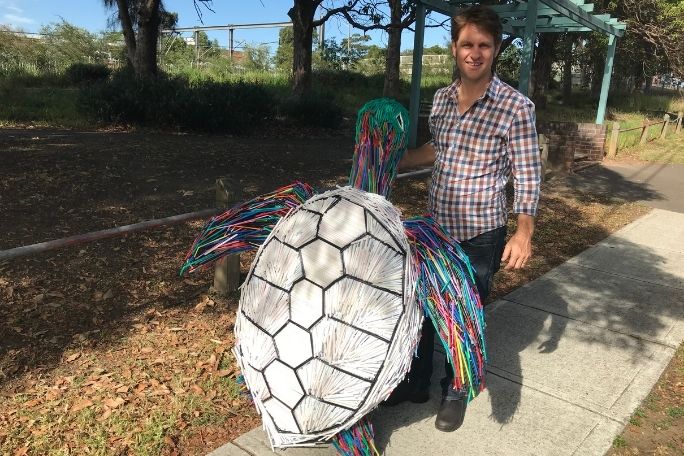Lesson summary
Students explore the impact of plastic straws on marine animals. They begin by sharing what they already know about single-use plastics, straws and our environment. They then explore the impacts of straws on marine animals in detail. Students work collaboratively to create a communication piece to share with their school or local community, the aim of which is to provide their community with reasons for not using plastic straws as well as information about alternatives to plastic straws.
Learning intentions:
Students will...
- understand what single-use plastics are
- understand that straws are one kind of single-use plastic that has a big impact on our environment
- understand that they can drive positive change for our environment.
Success criteria:
Students can...
- participate in class discussions
- work collaboratively or individually
- conduct a survey and analyse results to propose solutions to a real-world problem (optional)
- conduct and share research with an audience (optional)
- express and share thoughts and feelings about a real-world environmental issue through art (optional).
Lesson guides and printables
Lesson details
Curriculum mapping
Australian curriculum content descriptions:
Year 4 Science:
- Natural and processed materials have a range of physical properties that can influence their use (ACSSU074)
- Science knowledge helps people to understand the effect of their actions (ACSHE062)
- Represent and communicate observations, ideas and findings using formal and informal representations (ACSIS071)
Year 4 HASS:
- The use and management of natural resources and waste, and the different views on how to do this sustainably (ACHASSK090)
- Present ideas, findings and conclusions in texts and modes that incorporate digital and non-digital representations and discipline-specific terms (ACHASSI082)
Year 5 Science:
- Scientific knowledge is used to solve problems and inform personal and community decisions (ACSHE083)
- Communicate ideas, explanations and processes using scientific representations in a variety of ways, including multi-modal texts (ACSIS093)
Year 5 HASS:
- The environmental and human influences on the location and characteristics of a place and the management of spaces within them (ACHASSK113)
- Work in groups to generate responses to issues and challenges (ACHASSI102)
- Present ideas, findings, viewpoints and conclusions in a range of texts and modes that incorporate source materials, digital and non-digital representations and discipline-specific terms and conventions (ACHASSI105)
Year 6 HASS
- Develop appropriate questions to guide an inquiry about people, events, developments, places, systems and challenges (ACHASSI122)
- Organise and represent data in a range of formats including tables, graphs and large- and small-scale maps, using discipline-appropriate conventions (ACHASSI124)
- Locate and collect relevant information and data from primary sources and secondary sources (ACHASSI123)
- Work in groups to generate responses to issues and challenges (ACHASSI130)
- Reflect on learning to propose personal and/or collective action in response to an issue or challenge, and predict the probable effects (ACHASSI132)
Syllabus outcomes: ST2-13MW, ST2-11LW, ST2-4WS, ST3-7PW, ST3-4WS, GE2-2, GE2-3, GE2-4, GE3-2, GE3-3, GE3-4
General capabilities: Critical and Creative Thinking.
Cross-curriculum priority: Sustainability OI.9
Relevant parts of Year 4 Science achievement standards: Students apply the observable properties of materials to explain how objects and materials can be used, and they identify when science is used to understand the effect of their actions. They use formal and informal ways to communicate their observations and findings.
Relevant parts of Year 4 HASS achievement standards: Students identify the interconnections between components of the environment and between people and the environment, and present ideas, findings and conclusions using discipline-specific terms in a range of communication forms.
Relevant parts of Year 5 Science achievement standards: Students discuss how scientific developments help us solve problems. They communicate their ideas and findings using multi-modal texts.
Relevant parts of Year 5 HASS achievement standards: Students identify and describe the interconnections between people and the human and environmental characteristics of places, and present findings and ideas in a range of communication forms.
Relevant parts of Year 6 HASS achievement standards: Students develop appropriate questions to frame an investigation. They locate and collect useful data and information from primary and secondary sources. Students organise and represent data in a range of formats and collaboratively generate alternative responses to an issue.
This lesson is part of the wider unit of work: War On Waste – Years 4-6
Time required: 90+ mins
Level of teacher scaffolding: Medium to high – varies depending on the final task. A lower level of teacher scaffolding may be required for factsheet or art creation, while a higher level may be required for conducting and analysing surveys.
Resources required
- Device capable of presenting an online clip to the class
- Straws and Turtles Factsheet (optional)
- Student Worksheets – one copy per student
- Survey Design Tips (Year 6 only)
Skills
This lesson is designed to build students’ competencies in the following skills:
- Communication
- Community engagement
- Collaboration
- Critical thinking
Additional info
Cool Australia’s War On Waste lessons have been developed in partnership with Lune Media and with support from the Australian Environmental Grantmakers Network. These lessons have been designed to lead students through a deeper understanding of some of the big issues relating to waste in Australia and to support them to take action to reduce the impact of waste on our environment.


Welcome back!
Don't have an account yet?
Log in with:
By signing up to Cool.org you consent and agree to Cool's privacy policy to
store, manage and process your personal information. To read more, please see
our privacy policy here(Opens in new tab).
Create your free Cool.org account.
Many of our resources are free, with an option to upgrade to Cool+ for premium content.
Already have an account?
Sign up with:
By signing up to Cool.org you consent and agree to Cool's privacy policy to
store, manage and process your personal information. To read more, please see
our privacy policy here(Opens in new tab).